
Blanket the Ground – Native Groundcover Communities for Biodiversity, Habitat, and Beauty

Contributor
- Topics: Plants You Need, Sustainable Gardening
Summer 2023
With years of practice mothering her two bright daughters, Tammy raises her lawn replacement planting with equally gentle discipline. “Look,” she says, admiring the tight-knit groundcovers on the corner, “no weeds here!” An afternoon of rooting out opportunistic weeds nearby attunes her eye to the success of the sedums and Lydian broom and juniper (Sedum spurium ‘Dragon’s blood’, Sedum organum, Genista lydia, and Juniperus horizontalis ‘Wiltonii’). The way they cover the ground completely means that no weed seeds find an available niche to sprout. I suggest she pluck some bits of sedum to tuck in wherever she’s weeded to continue this pattern. She grasps my arm in agreement, “That’s exactly what I’ve been doing!”
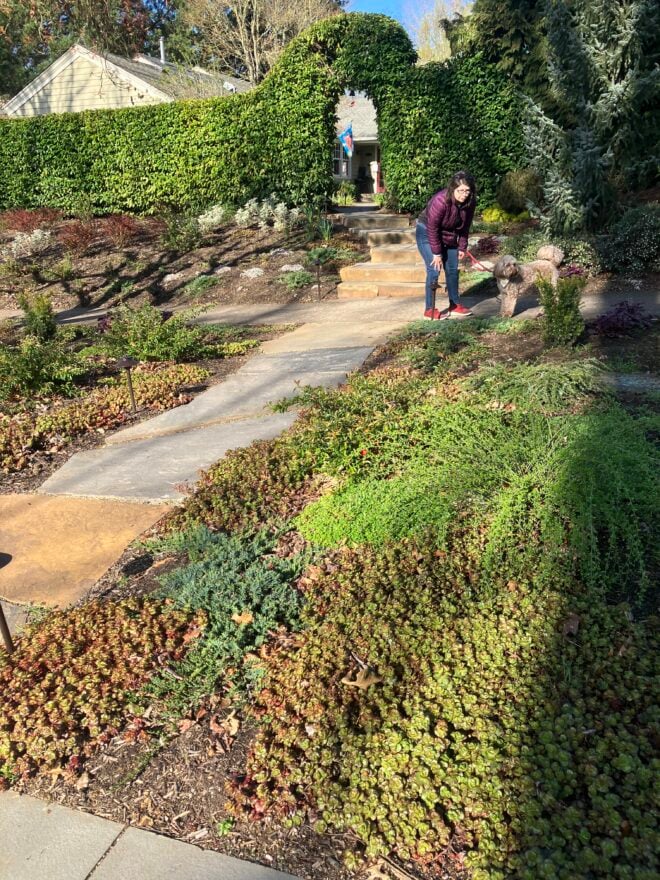
Nearly one hundred years ago, renowned Oregon landscape architect Elizabeth Lord wrote to a nurseryperson, “We find people will not put in anything unless they know it and unless their neighbor has it. They are so sheep-like in selection of plant material” (Libby 2021). Walking through some of the same neighborhoods Lord worked in today, I see signs of change. Where historically the same palette of 10–15 plants was repeated from house to house, there are now yards of wonder, of variety, of experimentation. Culture is embracing diversity.
If you’re like Tammy with her sedums, and you seek to enliven the gardening culture of your neighborhood, you have the opportunity to lead by example and to demonstrate relevant options. When your neighbors see a different mix of plants thriving in your yard, they may be inspired to experiment also.
A good place to start is with a refresh of the standard approach to groundcovers. This category includes plants that are typically low growing and low maintenance. Anything that blankets bare soil, suppresses weeds, and looks good year round can be used as a groundcover. In western Oregon, the same few species are used so frequently that you stop seeing them. They’re like concrete, so common they disappear, inspiring no sense of awe, contributing nothing to wildlife. In place of the vast expanses of periwinkle (Vinca minor), English ivy (Hedera helix), shrubby St. John’s wort (Hypericum prolificum), or, most ubiquitous of all, lawn, you could plant locally appropriate natives.
Where in your yard are you less inclined to putter, to weed, to trim and tend? What out-of-the-way spot needs a low maintenance solution that reflects your garden ethics and style? If your property has a hellstrip, a parking strip, a grassed area between sidewalk and street, this is a great place for groundcovers. Here your neighbors can admire and be inspired. Here you can pass by daily without having to bend and tend. Consider groundcovers in place of the front lawn, or along your driveway, or in a narrow side yard that you use for utility rather than outdoor living. Bare earth beneath trees and shrubs with root and water competition could be green and diverse instead of weedy and neglected. All these zones have the potential to be beautiful and to contribute to habitat without demanding a lot of effort.
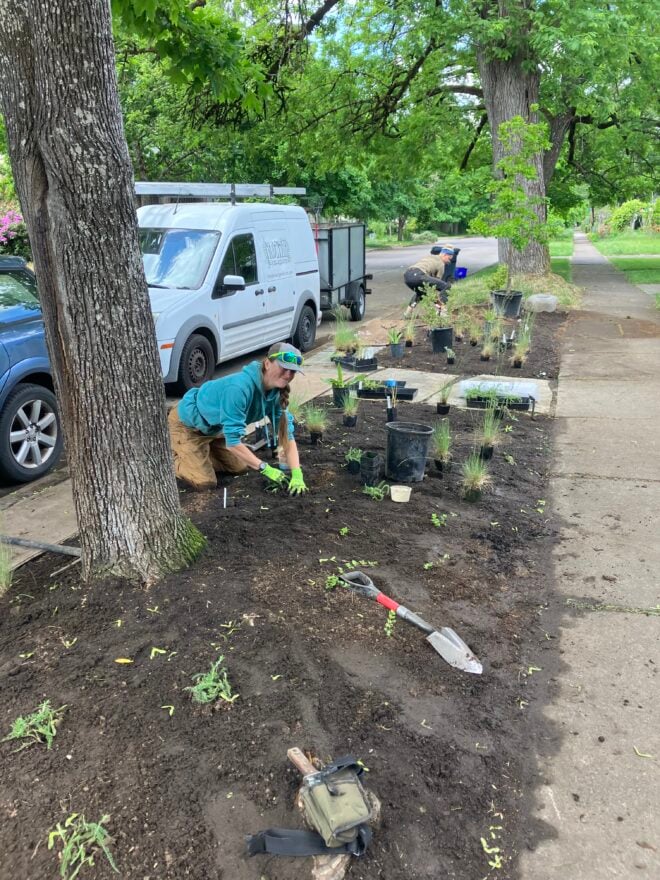
Before I give you suggestions of who to plant, look at self-willed, wild, or natural settings similar to your own. What’s the first thing you notice? In contrast to a managed landscape, you’ll see a mixed community of plants woven and layered together that cover the ground. Nature does not favor a monoculture. Complexity reigns. Embrace this tendency in your garden groundcover choices by planting at least three plant species together. Not only will it be more resilient than a single species, it will be beautiful year round. Your groundcover communities can support wildlife, engage the senses, inspire awe.
Here, I offer you three western native groundcover communities for different light and moisture levels. Root your own version of these communities firmly in the unique character of the place you garden.
Dry shade groundcover community
Imagine a quintessential Pacific Northwest scene. Does a shady forest of towering Douglas firs (Pseudotsuga menziesii) come to mind, with furrowed trunks massively vertical, winter rain dripping from overhead limbs, and green everywhere you look? For residents west of the Cascades, this feels like home. If you garden in such a shaded setting, you could use Pacific waterleaf (Hydrophyllum tenuipes), false Solomon’s Seal (Maianthemum racemosum), sword fern (Polystichum munitum), and candy flower (Claytonia sibirica) as your groundcover community. Gardening under trees can be challenging with extensive roots competing for available moisture. This community is well-adapted to dry shade and will thrive with little supplemental irrigation once it’s established.
Pacific waterleaf performs the same classic groundcover function as invasive English ivy (Hedera helix) and periwinkle (Vinca minor) in its will to expand. However, instead of creeping tendrils above ground that invade the root crowns of its companions, this native species spreads through its underground rhizomes, weaving around the taller, emergent species, knitting the ground together. When the fuzzy flower buds open in May to reveal pale lavender threads of pollen, you could be lucky enough to observe native black-tailed bumble bee (Bombus melanopygus) visiting your garden for a meal. A pollinator-attracting plant for shade is indeed a thing of wonder!
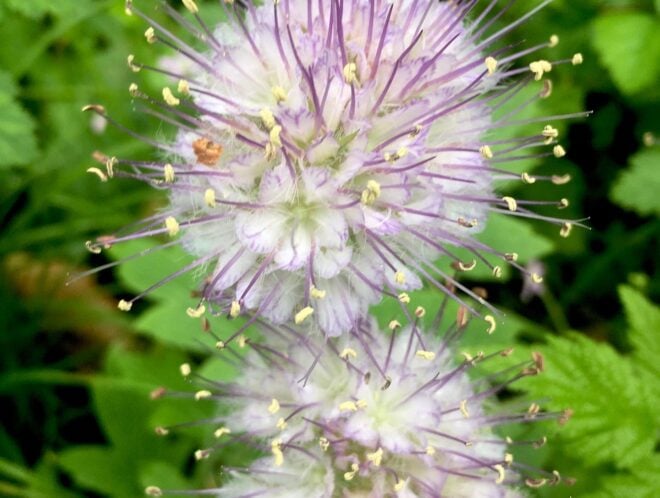
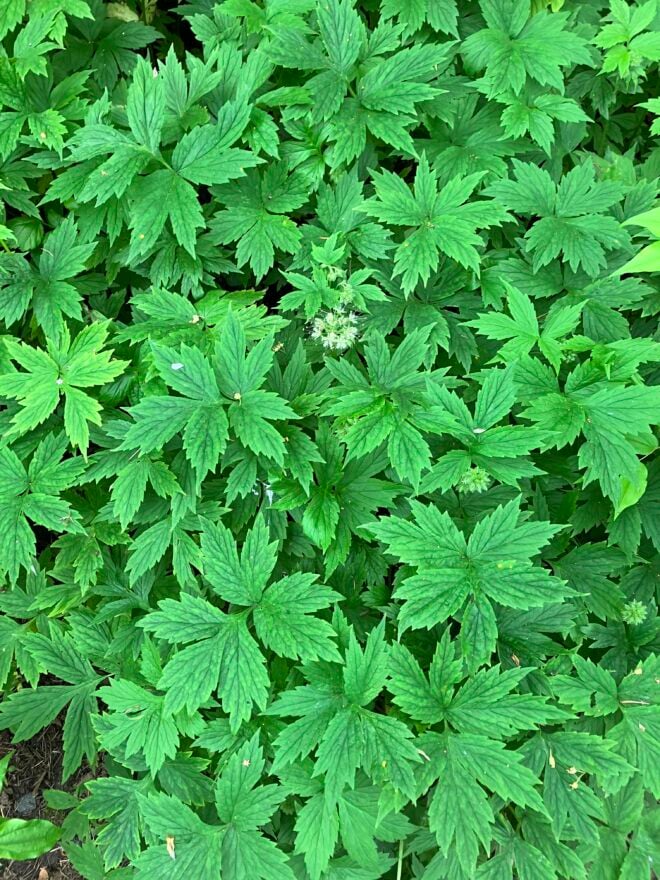
Pair waterleaf with emergent false Solomon’s seal and sword fern. These two rise above waterleaf, adding a two to three foot tall accent layer to your community. False Solomon’s seal’s white plumes of scented flowers coincide with waterleaf’s blooms for a spring celebration. Later, clusters of shiny red berries attract birds to the garden. Nonflowering sword fern earns its place in the mix with its reliable evergreenery and fascinating unfurling fronds.
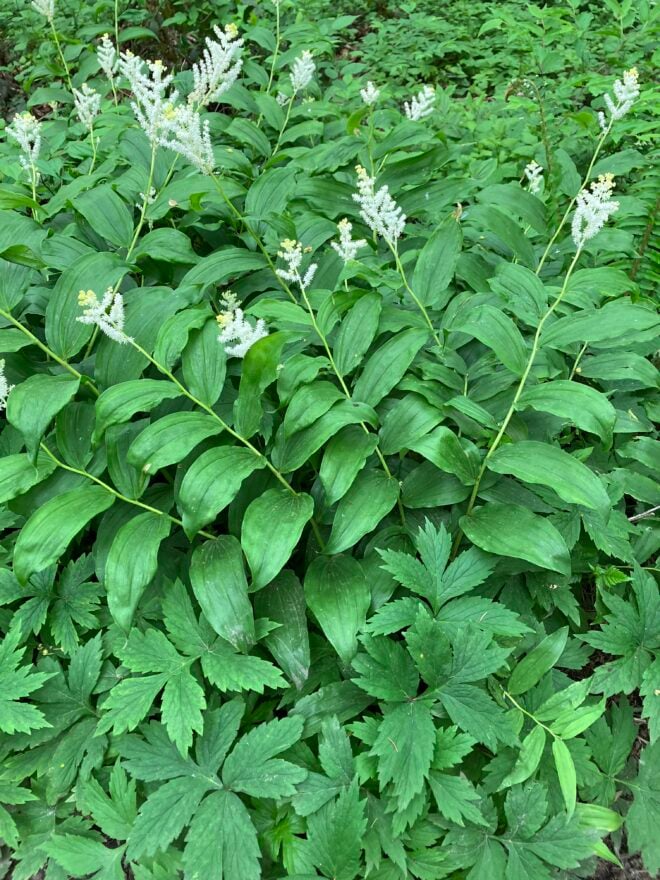
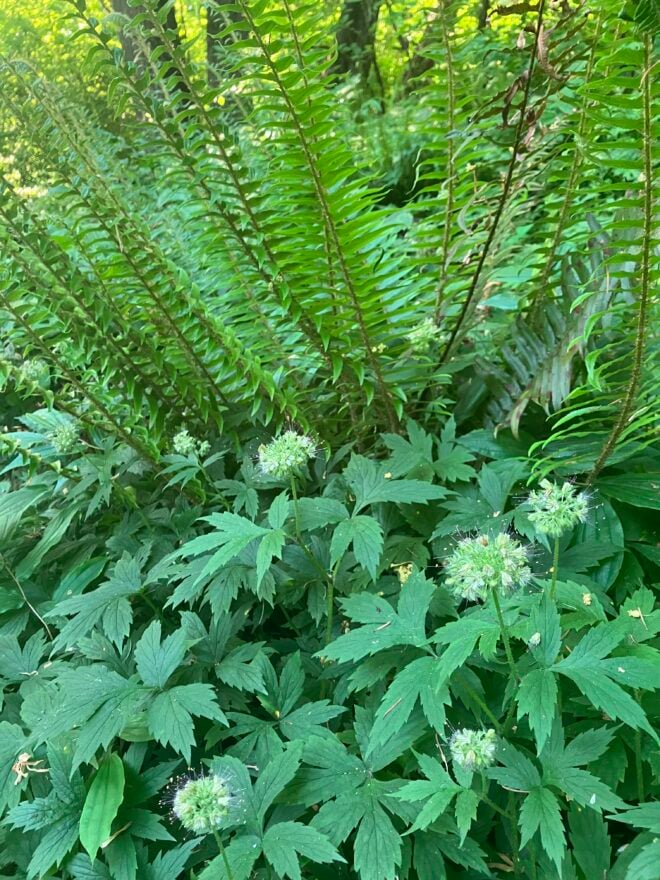
The final member of the dry shade community is a dynamic filler (to borrow Claudia West and Thomas Rainer’s term). Wherever the ground is bare, weeds will grow. This is why we plant groundcovers, to fill every niche and outcompete weeds. The role of the dynamic filler is to find the places the perennial members of the community haven’t yet spread before the weed seeds get ahold of the vacancy.
Candy flower (Claytonia sibirica) is especially suited to this role in our shaded sites because it germinates with the fall rains and occupies any available ground before the inundation of spring-sprouting weed competitors. You’ll love it for its pink and white starlike flowers all spring. It’s also a sweet addition to the salad bowl. Small species of native bees will thank you for strewing candy flower around. Just scatter seeds in fall or find starts in early spring to plug into the gaps. Allow them to self-sow for a continual display of this annual’s flowers in your mix. It’s the perfect native replacement for forget-me-nots (Myosotis sylvatica).
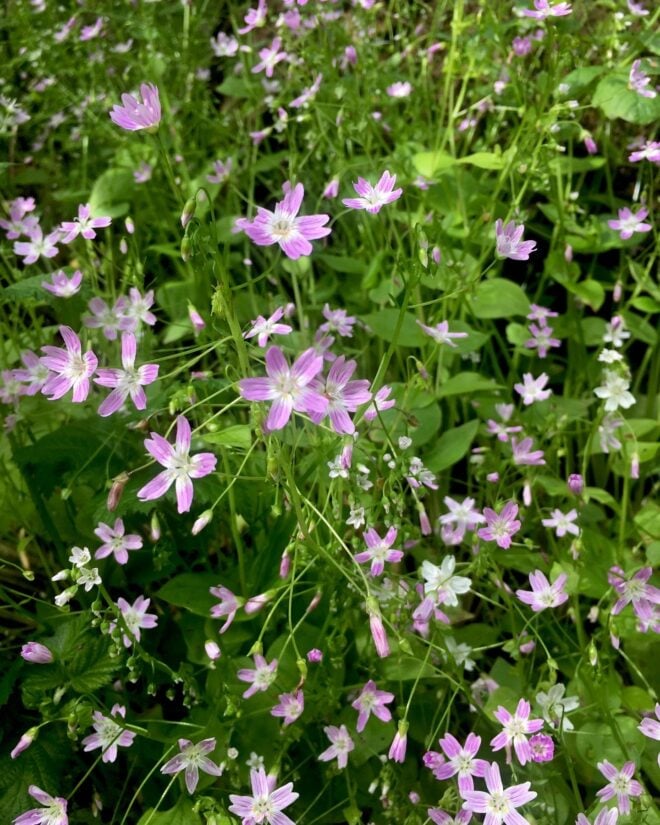
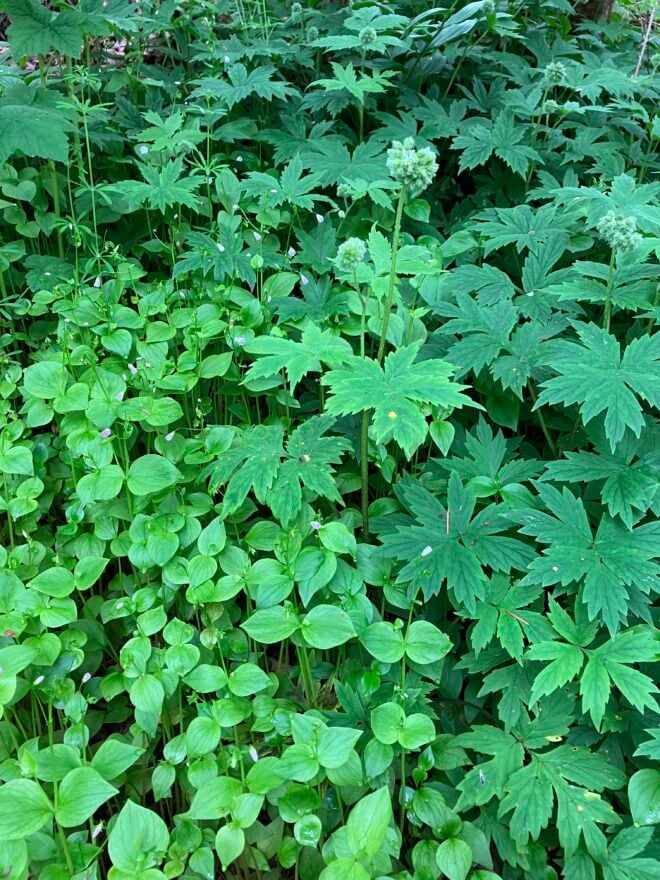
Moist sun to light shade groundcover community
Do you have a winter wet lawn, sodden with seasonal standing water, unusable, frustrating ground? You try to drain it, but the high water table and clay soil leaves nowhere for the water to go. You’re fighting reality when you could celebrate it with native groundcovers that are adapted to just such conditions.
Maybe you live near the threat of wildfires and want to protect your home with Firewise landscaping. An irrigated zone of moisture-loving plants could be the way to go for you, too.
Let lanceleaf self-heal (Prunella vulgaris var. lanceolata), tufted hairgrass (Deschampsia cespitosa), camas (Camassia quamash), rosy checkermallow (Sidalcea virgata), and western buttercup (Ranunculus occidentalis) cover your ground in moist sun to dappled shade. You’ll enjoy complementary colored blooms spring into summer, light-catching seed heads fall into winter, and green, weed-suppressing foliage year round.
Lanceleaf self-heal (Prunella vulgaris var. lanceolata) is the weft in this community. It spreads to fill every niche around the emergent perennials and bulbs. It’s taller with bigger purple blooms than its weedy Eurasian relative (P. vulgaris var. vulgaris). Learning about this variety can be a game changer. What you once disdained as invasive has a better-looking native relative! You’ll delight in the perching owl structure of its seed heads and the free offspring they sow. Of course, you could deadhead them for both a repeat bloom and fewer self-sowers, but who’s to bemoan the proliferation of a native, pollinator-attracting beauty on bare ground that otherwise would be claimed by weeds?
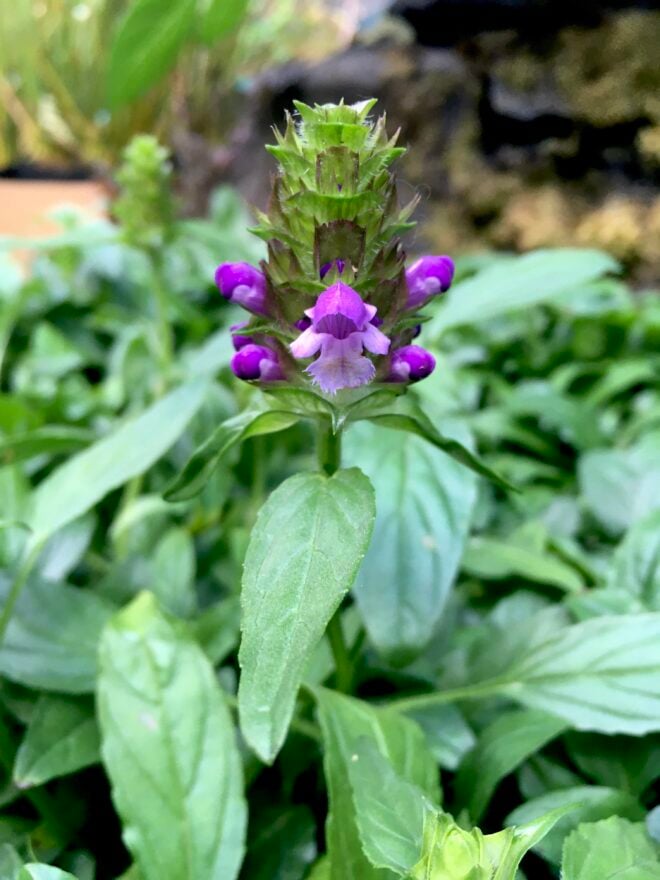
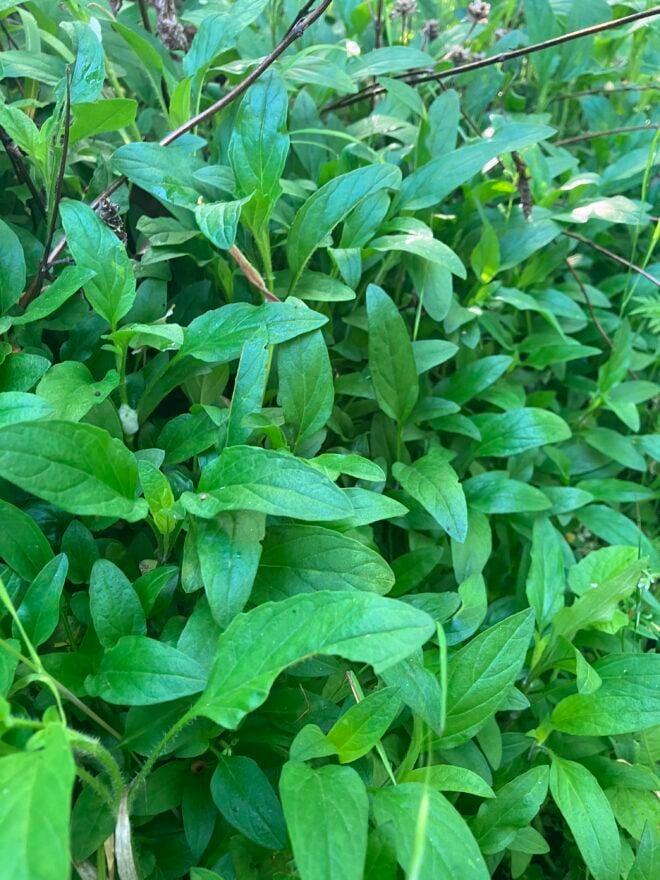
Tufted hairgrass, our Pacific Northwest native that traveled to Europe to get trendy, stands as a structural component in this mix. With a two-foot evergreen fountain of leaves, topped with flowers and, later, seed heads of spun gold, you’ll love this native grass even if you’re not a “grass person.” As part of a groundcover community where it’s planted over a large scale, the repetition of tufted hairgrass reads beautifully. It naturalizes the scene while simultaneously offering a legible pattern that the human gaze can intuitively understand.
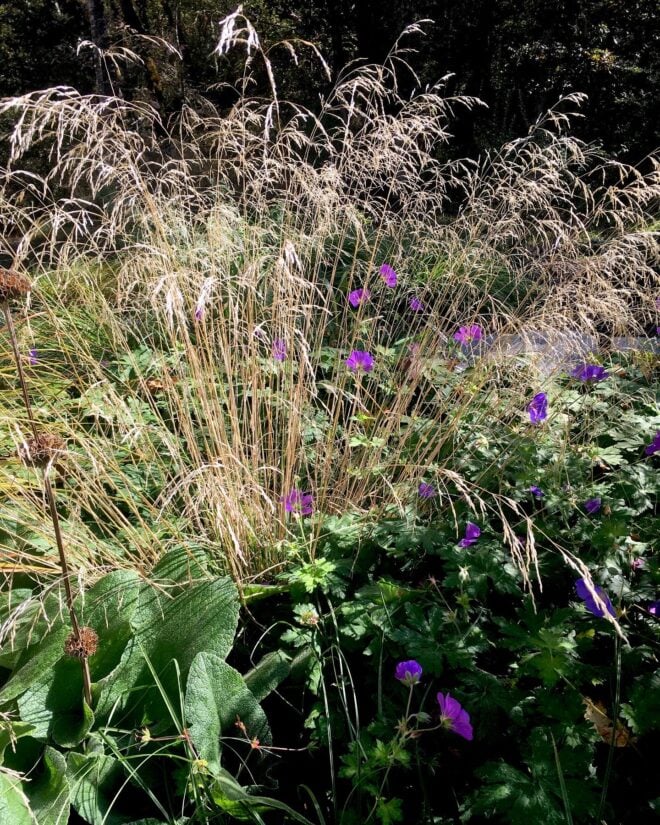
The next three members of this community contribute color and a rooted sense of place. Camas, coloring fields in watery blue each May, is pivotal to the cultural history of the Pacific Northwest. Planted in your garden, it honors Indigenous peoples’ cultivation of camas bulbs for food. And, as a groundcover, you can celebrate its will to spread instead of complaining that it’s “too aggressive.” You might even try your hand at digging bulbs for roasting!
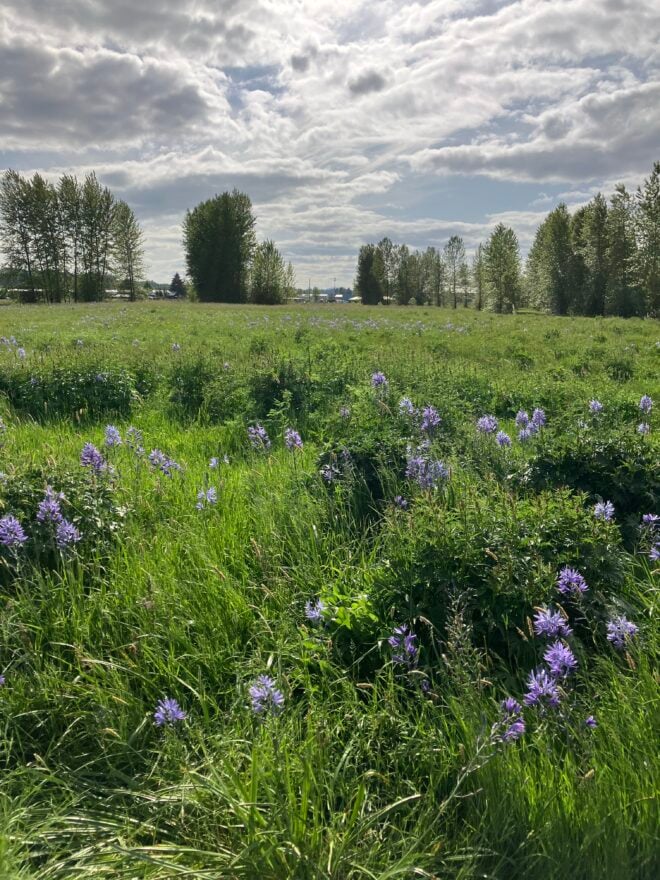
Rosy checkermallow and western buttercup are natural camas companions. Imagine a muddy lawn enlivened with washes of blue, polka dots of pink, and spatters of yellow. Here’s something the neighbors will notice! In winter, you’ll appreciate checkermallow’s evergreen rosette of weed-suppressing leaves—it’s quite handsome and this trait makes it a worthy groundcover. The wiry stems of western buttercup weave and reseed through the moist sun in the same way that candy flower does in the shade, making it the dynamic filler of the community. Any gap can allow buttercup to claim ground, rather than a weed seed.
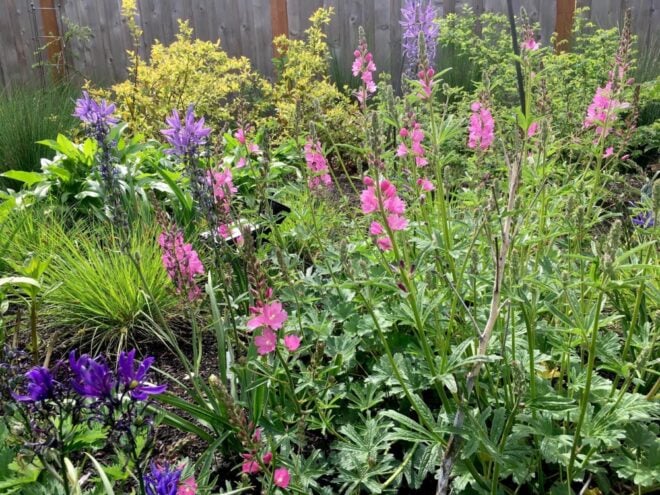
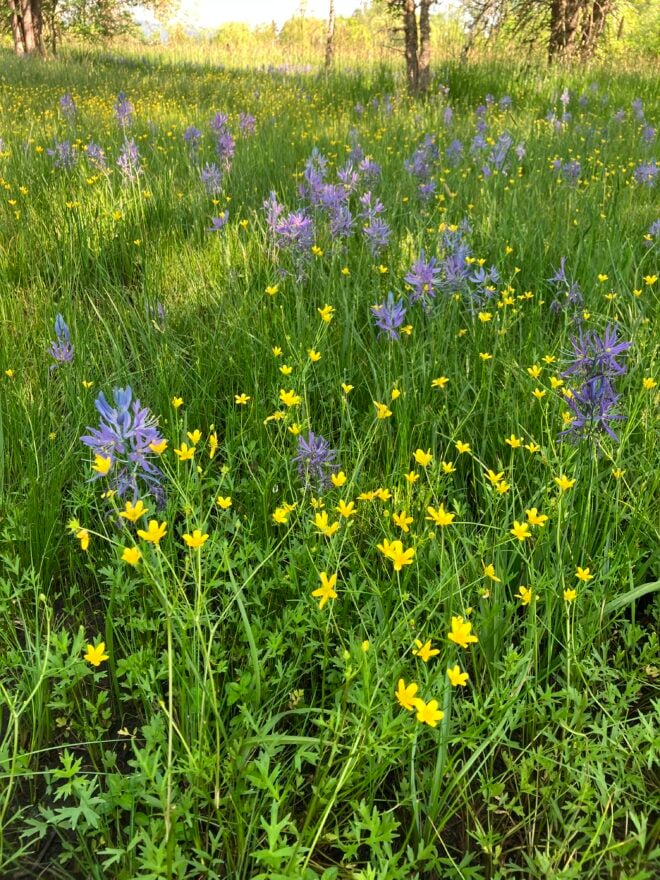
Hot, dry, sunny groundcover community
From urban hellstrips to the sun-drenched back forty, you’ll encounter weedy zones of lean soil and little access to irrigation. If your land is fast draining, gritty, and bakes in the summer sun, plant a mix of Oregon sunshine (Eriophyllum lanatum), Roemer’s fescue (Festuca roemeri), yarrow (Achillea millefolium), and California poppy (Eschscholzia californica) to cover the ground.
This is one tough community of plants. The combination supports a diversity of beneficial insects and pollinators that will bring your former weed patch to life. And, more than the other mixes in this essay, this one can establish successfully from seed. If you take the time to prepare the ground and eliminate weed seeds first, you’ll enjoy a lively groundcover scene for significantly less money than if you were to start from nursery plants. (See Making Meadows in Resources to learn how to prepare ground for seeded groundcovers—this is not a step to rush.)
Oregon sunshine can be variable depending on the soil, the climate, and the seed source. I usually see it as a dense, weed-suppressing mat of pale foliage that I can’t resist petting like a dear cat. But in the leanest ground, it can be upright and wispy—its delicacy belying a truly tenacious character. Summerlong blooms of brightest yellow give this plant its name, which is also aptly known as woolly sunflower. Pollinators, in both abundance of quantity and diversity, visit Oregon sunshine, making it popular with gardeners who enjoy bee-ing (or bee watching). Do you let yourself get lost in the simple act of observing bees? Let Oregon sunshine weave generously as a groundcover in your hottest site. It will transform from a place you’ve avoided to one that draws you to meditate.
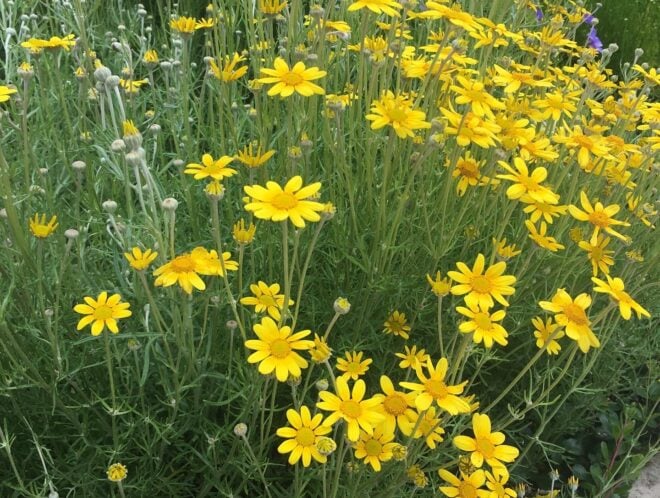
Evoke the romance of a meadow in your groundcover planting with Roemer’s fescue. Mounding fountains of thin, bluish leaves, planted in groups of seven, five, three, or singly throughout the community, make a pattern. The delicate flowers dance in the wind, catching light and attention. Roemer’s fescue offers cover, nesting material, and nourishment for butterfly larvae, and bees – a beautiful habitat.

Yarrow brings a lusher shade of green to the mix. Its drought-adapted leaves are feathers of freshness throughout summer. With expanding rhizomes, yarrow is designed to cover ground. When I hear complaints of it being aggressive, I must suggest that yarrow is just not being appreciated for its nature, which is to spread. Pairing it with Oregon sunshine and Roemer’s fescue (equally extroverted types when it comes to plant sociability) allows yarrow to be itself. They strike a harmonious balance. You’ll love the stiff-stemmed, white floral landing pads as a structural contribution to the combination. Winged creatures alight here, too. This groundcover community is all the buzz!
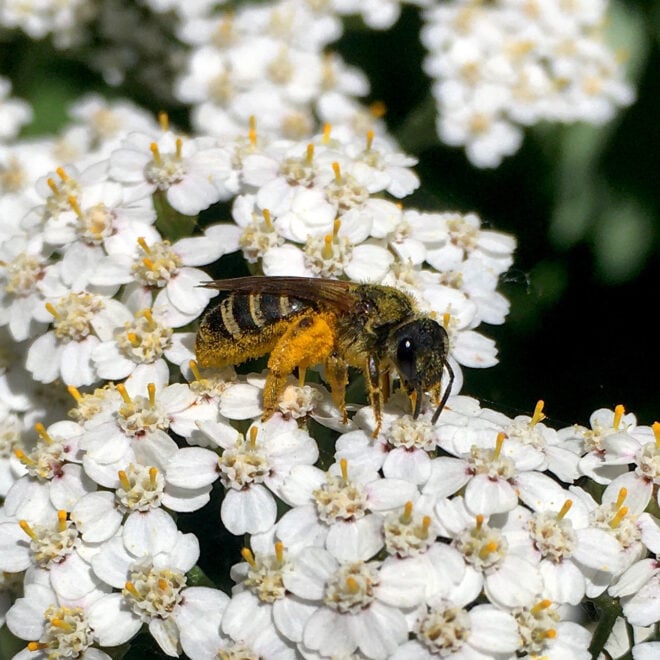
Finally, a scattering of California poppies act as dynamic filler in the mix. Like candy flower in the shade and western buttercup in moist sun, California poppies outcompete weeds in any open ground. Their seeds germinate with fall rains and grow leafy and fresh through winter before most weeds get a chance. This is why I want you to include a dynamic filler, a self-seeding wildflower, an ever-changing element in your groundcover. Visually, the foliage of California poppies is calmly complementary, while the flowers stun and delight in shining orange and glowing gold. A piece of California’s famed superbloom could be yours!
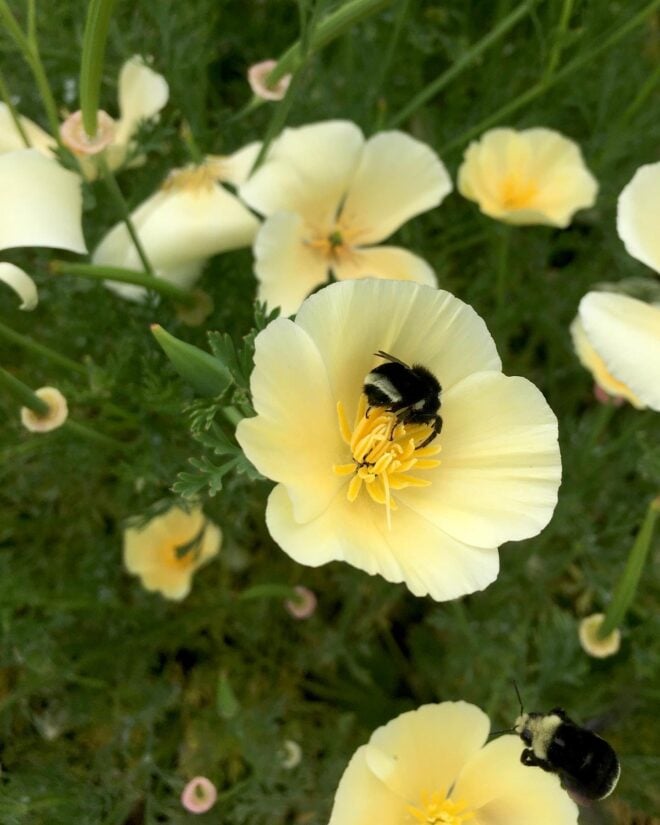
Conclusion
You can make a difference. Start with one patch of neglected ground, notice its character (shady or sunny, wet or dry), clear the invasive and weedy, and get to planting native groundcovers. If none of the mixes I described here are right for where you live, use the ideas to formulate your own. Include a spreading species, something with good year-round structure, and another that can function as your “dynamic filler” to self-sow and outcompete weed seeds. Let the nearby wild places you enjoy inform your choices.
Your efforts and attention during the establishment of your groundcover community will be rewarded with winged wonders and admiring gazes. Keep in mind that it will take some work to establish. There’s a reason the smothering monoculture groundcovers have been so popular—their aggressive growth is easy enough for the non-botanically inclined to plant. Isn’t it time to do something meaningful and to contribute? Let a monthly pass to weed and tend your young planting be self-care. As you care for the garden, it reciprocates by bolstering your sense of well-being. The benefits compound each year as the planting naturalizes and requires less of you while offering more beauty and increased habitat.
Resources
Libby, Valencia. 2021. The Northwest Gardens of Lord & Schryver. Corvallis: Oregon State University Press.
Rainer, Thomas and Claudia West. 2015. Planting in a Post-Wild World: Designing Plant Communities for Resilient Landscapes. Portland: Timber Press.
Currin, Kristin and Andrew Merritt. 2023. The Pacific Northwest Plant Primer: 255 Plants for an Earth-Friendly Garden. Portland: Timber Press.
Northwest Meadowscapes. Making Meadows: Creating Wildflower Ecosystems West of the Cascade Mountains.
This article was sponsored by: Sunset Plant Collection










Responses